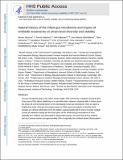| dc.contributor.author | Yassour, Moran | |
| dc.contributor.author | Vatanen, Tommi | |
| dc.contributor.author | Siljander, Heli | |
| dc.contributor.author | Hämäläinen, Anu-Maaria | |
| dc.contributor.author | Härkönen, Taina | |
| dc.contributor.author | Ryhänen, Samppa J. | |
| dc.contributor.author | Franzosa, Eric A. | |
| dc.contributor.author | Vlamakis, Hera | |
| dc.contributor.author | Huttenhower, Curtis | |
| dc.contributor.author | Gevers, Dirk | |
| dc.contributor.author | Knip, Mikael | |
| dc.contributor.author | Lander, Eric Steven | |
| dc.contributor.author | Xavier, Ramnik Joseph | |
| dc.date.accessioned | 2018-06-29T18:33:37Z | |
| dc.date.available | 2018-06-29T18:33:37Z | |
| dc.date.issued | 2015-06 | |
| dc.identifier.issn | 1946-6234 | |
| dc.identifier.issn | 1946-6242 | |
| dc.identifier.uri | http://hdl.handle.net/1721.1/116700 | |
| dc.description.abstract | The gut microbial community is dynamic during the first 3 years of life, before stabilizing to an adult-like state. However, little is known about the impact of environmental factors on the developing human gut microbiome. We report a longitudinal study of the gut microbiome based on DNA sequence analysis of monthly stool samples and clinical information from 39 children, about half of whom received multiple courses of antibiotics during the first 3 years of life. Whereas the gut microbiome of most children born by vaginal delivery was dominated by Bacteroides species, the four children born by cesarean section and about 20% of vaginally born children lacked Bacteroides in the first 6 to 18 months of life. Longitudinal sampling, coupled with whole-genome shotgun sequencing, allowed detection of strain-level variation as well as the abundance of antibiotic resistance genes. The microbiota of antibiotic-treated children was less diverse in terms of both bacterial species and strains, with some species often dominated by single strains. In addition, we observed short-term composition changes between consecutive samples from children treated with antibiotics. Antibiotic resistance genes carried on microbial chromosomes showed a peak in abundance after antibiotic treatment followed by a sharp decline, whereas some genes carried on mobile elements persisted longer after antibiotic therapy ended. Our results highlight the value of high-density longitudinal sampling studies with high-resolution strain profiling for studying the establishment and response to perturbation of the infant gut microbiome. | en_US |
| dc.description.sponsorship | National Human Genome Research Institute (U.S.) (grant 2U54HG003067-10) | en_US |
| dc.description.sponsorship | Juvenile Diabetes Research Foundation International | en_US |
| dc.description.sponsorship | National Institutes of Health (U.S.) (grant U54 DK102557) | en_US |
| dc.description.sponsorship | National Institutes of Health (U.S.) (grant R01 DK092405) | en_US |
| dc.description.sponsorship | National Institutes of Health (U.S.) (grant P30 DK043351) | en_US |
| dc.description.sponsorship | Leona M. and Harry B. Helmsley Charitable Trust | en_US |
| dc.description.sponsorship | Crohn's and Colitis Foundation of America | en_US |
| dc.publisher | American Association for the Advancement of Science (AAAS) | en_US |
| dc.relation.isversionof | http://dx.doi.org/10.1126/SCITRANSLMED.AAD0917 | en_US |
| dc.rights | Creative Commons Attribution-Noncommercial-Share Alike | en_US |
| dc.rights.uri | http://creativecommons.org/licenses/by-nc-sa/4.0/ | en_US |
| dc.source | PMC | en_US |
| dc.title | Natural history of the infant gut microbiome and impact of antibiotic treatment on bacterial strain diversity and stability | en_US |
| dc.type | Article | en_US |
| dc.identifier.citation | Yassour, Moran, Tommi Vatanen, Heli Siljander, Anu-Maaria Hämäläinen, Taina Härkönen, Samppa J. Ryhänen, Eric A. Franzosa, et al. “Natural History of the Infant Gut Microbiome and Impact of Antibiotic Treatment on Bacterial Strain Diversity and Stability.” Science Translational Medicine 8, no. 343 (June 15, 2016): 343ra81–343ra81. | en_US |
| dc.contributor.department | Massachusetts Institute of Technology. Center for Microbiome Informatics and Therapeutics | en_US |
| dc.contributor.department | Institute for Medical Engineering and Science | en_US |
| dc.contributor.department | Massachusetts Institute of Technology. Department of Biology | en_US |
| dc.contributor.mitauthor | Lander, Eric Steven | |
| dc.contributor.mitauthor | Xavier, Ramnik Joseph | |
| dc.relation.journal | Science Translational Medicine | en_US |
| dc.eprint.version | Author's final manuscript | en_US |
| dc.type.uri | http://purl.org/eprint/type/JournalArticle | en_US |
| eprint.status | http://purl.org/eprint/status/PeerReviewed | en_US |
| dc.date.updated | 2018-06-28T15:42:46Z | |
| dspace.orderedauthors | Yassour, Moran; Vatanen, Tommi; Siljander, Heli; Hämäläinen, Anu-Maaria; Härkönen, Taina; Ryhänen, Samppa J.; Franzosa, Eric A.; Vlamakis, Hera; Huttenhower, Curtis; Gevers, Dirk; Lander, Eric S.; Knip, Mikael; Xavier, Ramnik J. | en_US |
| dspace.embargo.terms | N | en_US |
| mit.license | OPEN_ACCESS_POLICY | en_US |
